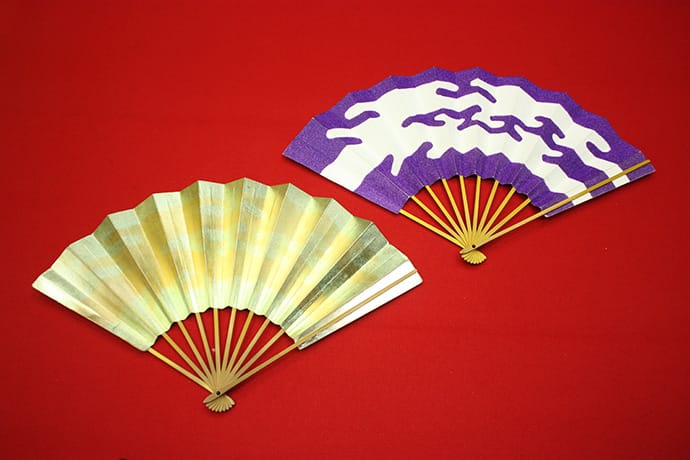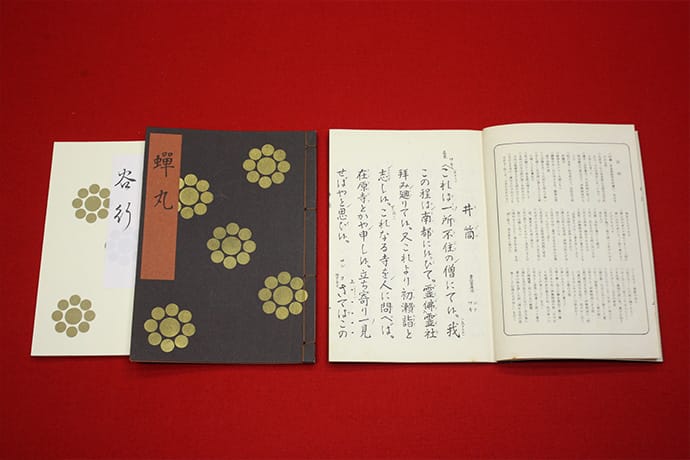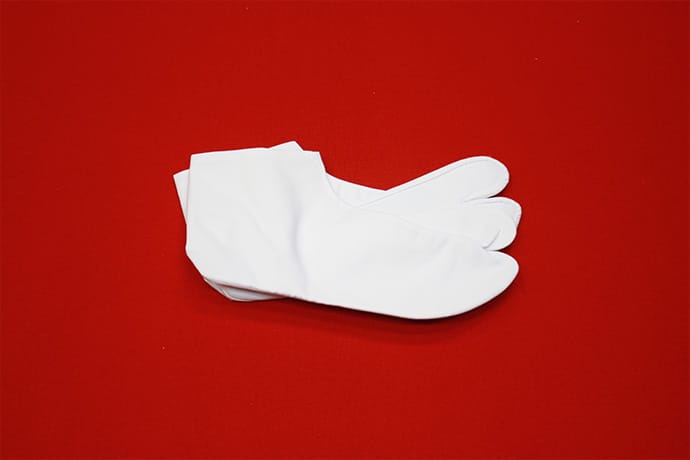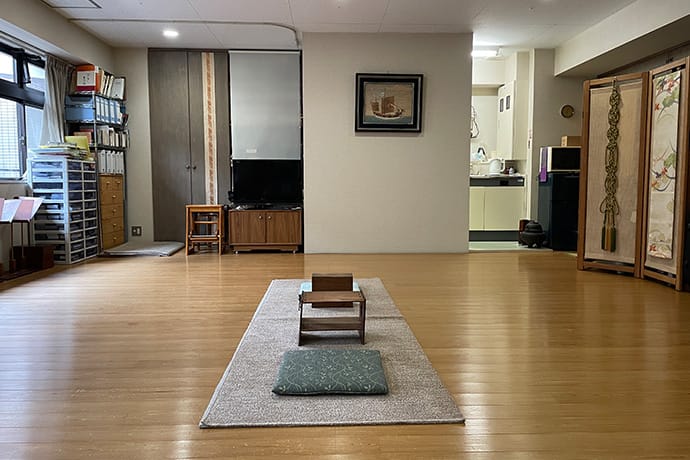能を嗜む
Experiencing Noh
お能は観るもの……そう思っていませんか?能は観るだけでなく嗜むもの。豊臣秀吉をはじめ諸大名や剣術家、琳派を代表するアーティストや文豪達……歴史上の様々な人物達も観るだけではなく自ら謡い舞う事で能を嗜んできました。
能には和歌や漢詩など、この世界を美しく表現する言葉で溢れています。それを声に出して、または身体にのせて表現するお稽古は、自分の感性と向き合う時間です。能には茶道や禅の思想にも通じるところが多くありますので、日々の暮らしの中で様々な物事を発見するきっかけにもなります。あなたも能をやってみませんか?
Do you think Noh is something to watch ......? Noh is not only to watch but also to enjoy. Toyotomi Hideyoshi and other lords, swordsmiths, artists representing the Rimpa school, and great writers...... have enjoyed Noh not only by watching it, but also by chanting and dancing it themselves.
Noh is filled with waka poems, Chinese poetry, and other words that express this world beautifully. The practice of expressing these words aloud or with the body is a time to confront one's own sensibilities. Noh also has many similarities to the tea ceremony and the philosophy of Zen, so it can be an opportunity to discover various things in your daily life. Would you like to try Noh?

謡のお稽古 Noh chanting practice
能の台本とも言える謡本を使って謡います。謡本には「節(ふし)」と言われる記号があり、音の高さやメロディ・リズム・情感などが込められています。金剛流ではおよそ200曲の演目があり、季節や物語・登場人物によって謡い分けていきます。
The chanting is performed using a chant book, which can be called a script of Noh. The chant book contains symbols called "fushi," which indicate the pitch of the notes, melody, rhythm, and emotion of the songs. The Kongo School has approximately 200 songs, which are sung according to season, story, and characters.
謡のお稽古は師匠と向き合って Practice chanting face to face with the master.
最初は師匠の謡を聞いて、それを真似する「鸚鵡返し」という伝統的なお稽古から始まります。お能一曲を何回かに分けて少しずつ謡い進めて、最後の仕上げは一曲通して謡います。少し大変ですが謡い終わった時の爽快感はなんとも言えません。
At first, the class begins with the traditional practice of "parroting," in which students listen to the master's chants and imitate them. The final step is to chant the entire piece. It is a bit of hard work, but the exhilarating feeling when the chanting is over is indescribable.

舞のお稽古 Dancing practice
舞は型と呼ばれる基本動作の組み合わせで舞います。最初は2分程度の舞を舞うのも難しいのですが、慣れてくると10分の舞や、お能一番を舞う事も出来る様になります。
The dance is a combination of basic movements called kata. At first, it is difficult to perform a two-minute dance, but as one becomes accustomed to it, one can perform a 10-minute dance or an Onoh Ichiban.
能舞台に立つ Be on the Noh stage
お稽古の成果を舞台の上で披露する事が出来ます。プロの能楽師達と一緒に舞台に立つ事で、普段のお稽古では味わえない一期一会の瞬間を楽しむ事が出来ます。また、日頃のお稽古のモチベーションにも繋がります。
You can show the results of your practice on the stage. By standing on stage with professional Noh performers, you can enjoy a once-in-a-lifetime moment that you cannot experience in your regular practice. It will also motivate you to continue your daily practice.
アイテム Items
-

扇
能に使う扇は流儀によって違います。金剛流は骨(竹の部分)の形状が末広がりになっています。
Folding fan
The fans used in Noh differ according to the style. In the Kongo style, the bone (the bamboo part) has a tapering shape.
-

謡本
金剛流の流儀の紋・九曜紋のあしらわれた和綴の謡本です。中には変体仮名文字で書かれた謡本もあります。(お稽古の時には読み方も一緒にお教え致します)
Book of songs
These are chant books in Japanese spelling decorated with the kuyo-mon, the ritual crest of the Kongo-ryu. Some chant books are written in variant kana characters. (We will teach you how to read them at the time of practice.)
-

足袋
能のお稽古の時には白足袋を履きます。気持ちも引き締まってお稽古に集中出来ます。
Tabi
I wear white tabi socks when I practice Noh. I feel more relaxed and can concentrate on my practice.
お稽古場 lessons
-

京都教室
火曜日・水曜日・金曜日(各2回/月)
景雲会敷舞台
〒606-0047
京都市左京区上高野薩田町111Kyoto Class
Tuesday, Wednesday, Friday (2 times/month each)
Keiunkai Shiki Stage
〒606-0047
111 Satsuda-cho, Kamitakano, Sakyo-ku, Kyoto, Japan -

名古屋教室
土曜日(1回/月)
栄能楽堂
〒460-0008
愛知県名古屋市中区栄5丁目6-4 栄能楽ビル4FNagoya Class
Saturday (once/month)
Sakae Noh Theatre
〒460-0008
Sakae Nohgaku Building 4F, 5-6-4 Sakae, Naka-ku, Nagoya City, Aichi Prefecture -

東京教室
土曜日又は日曜日(1回/月)
鳩森八幡神社 能楽殿
〒151-0051
東京都渋谷区千駄ヶ谷1丁目1-24Tokyo Class
Saturday or Sunday (once/month)
Hatomori Hachiman Shrine Noh Theatre
〒151-0051
1-1-24 Sendagaya, Shibuya-ku, Tokyo -

横浜教室
月曜日(1回/月)
久良岐会稽古場
神奈川県横浜市中区日ノ出町1-76-1
インペリアル横浜パークサイド2FYokohama Class
Monday (once/month)
久良岐会稽古場
神奈川県横浜市中区日ノ出町1-76-1
インペリアル横浜パークサイド2F
入会金・お月謝 Fee
- 入会金 Admission fee
- 15,000円
-
- 京都 Kyoto
-
月2回
謡 15,000円
謡+仕舞 20,000円
-
- 名古屋 Nagoya
-
月1回
謡 10,000円
謡+仕舞 15,000円
-
- 東京 Tokyo
-
月1回
謡 15,000円
謡+仕舞 20,000円
-
- 横浜 Yokohama
-
月1回
謡 15,000円
謡+仕舞 20,000円
Q&A
-
- お能のお稽古は全く初めてなのですが大丈夫ですか?
- もちろんです。お稽古に興味を持たれたきっかけや、モチベーションは人それぞれなので、最初にお話し合いをさせて頂き、お稽古の方針を決めていきましょう。
-
- お稽古を始めるのに年齢制限はありますか?
- 子供がお稽古事を始めるのは六歳になる年の六月六日が良いとされます。お能のお稽古をなさる方は、小さなお子さんからご高齢の方まで幅広い年齢層があります。
-
- お稽古に必要なものはどうやって揃えたらいいですか?
-
まずは謡本・扇・白足袋が必要になります。
謡本は東京にある檜書店(ひのきしょてん)で購入できます。オンラインストアはこちら
扇は京都の東本願寺近くにある本家十松屋さん(京都市下京区上珠数屋町通東洞院東入ル TEL 075-361-0074075-361-0074)で購入できます。昔ながらのお店なので一度お電話されてから行かれることをお勧めします。
※京都以外の教室では私が代理で購入する事も可能です。白足袋は色々なものがありますが、株式会社皆中(かいちゅう)のノーアイロン足袋は比較的安価で手入れも簡単ですので普段使いにお勧めです。オンラインストアはこちら
-
- 発表会などはありますか?
- 私の教室では通常年に二回、新年会と夏の会を開催しています。日々のお稽古の目標になるとモチベーションが上がります。発表会は別途経費がかかりますが、参加は自由です。
-
- 正座が苦手なのですが椅子でのお稽古は可能ですか?
- ご高齢の方や、足の具合が悪い方には椅子でのお稽古をお勧めします。まずはご相談ください。
-
- 娘の結婚式で高砂の謡を謡いたいのですが、期間限定でのお稽古は可能ですか?
- この度はおめでとうございます!もちろん大歓迎です。謡い方だけでなく、着物の着方や謡う時の所作などもご指導いたします。
-
- プロの能楽師になれますか?
- プロの能楽師の全員が世襲の家の子という事ではありませんので、なれる可能性はあります。長い修行期間と日々の鍛錬が必要なので、その覚悟があるならばお力添えいたします。